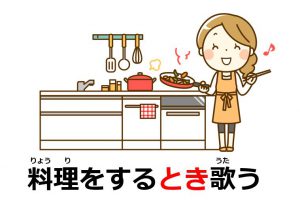Last time, you learned negative sequential and parallel actions, e.g. “電気を消さないで寝ました (I went to bed without turning off the light),” and “私は虫が好きじゃなくて、動物が好きなんです (I didn’t like insects, but animals).” Then, if you want to say, “I went to bed while wearing clothes,” what you should do? In this lesson, you will learn how to express simultaneous actions.
Explanation for the Usage of …ながら and …たまま
| Table of Contents …ながら: Simultaneous Actions …たまま: Simultaneous Actions Indicating Resultant States |
Simultaneous actions mean that two or more actions take place at the same time. When it comes to parallel actions, each action is independent, e.g. “I will eat rice and my mother will eat bread.” However, simultaneous actions have the same subject, e.g. I’m eating rice while eating bread.” In Japanese, we use the key words: …ながら and …たまま to express them. Let’s check how they work.
…ながら: Simultaneous Actions
| [私は] テレビを見ながら | 宿題を(した / しました) |
| Sub Action | Main Action |
| [I] did homework while watching TV. | |
ながら can express simultaneous actions and be translated as “while” in English. The conjugation is to utilize the polite form and attach ながら instead of ます. The important point here is that you cannot apply the ta-form for the ながら part even if the sentence is in past tense. With this sentence pattern, the ながら part should be a sub action.
| 歌いながら本を(読む / 読みます)。 [I] will read a book while singing. |
| 辞書を使いながら勉強して(いる / います)。 [I] am studying while using the dictionary. |
| 泣きながら(謝った / 謝りました)。 [I] apologized while crying. |
| 話しながらご飯を食べて(いた / いました)。 [I] was eating a meal while talking. |
You cannot use ながら for actions which take place for a moment like “死ぬ: to die,” and “割れる: to break” because there is no time to simultaneously do main actions. In that case, you need to use the te-form to express sequential actions.
=> Wrong! |
| ガラスが割れて大きな音が(した / しました)。 The glass broke and it made a big noise. |
[adsense]
…たまま: Simultaneous Actions Indicating Resultant States
| [私は] 電気をつけたまま | 寝て(しまった / しまいました) |
| Sub Action | Main Action |
| [I] fell asleep with the light still on. | |
When you use verbs which indicate resultant states in the sub action, you have to use たまま instead of ながら. The conjugation is to attach まま to the end of the ta-form.
| 立ったままご飯を(食べる / 食べます)。 [I] will eat a meal while standing. |
| 窓を開けたまま家を(出る / 出ます)。 [I] will leave my house with the window open. |
| 靴を履いたまま家に入れ(ない / ません)。 [You] can’t enter a house with your shoes on. |
| 服を着たまま海で(泳いだ / 泳ぎました)。 [I] swam in the sea while wearing clothes. |
Japanese people sometimes attach で to たまま. However, this does not change the meaning.
| 立ったままでご飯を(食べる / 食べます)。 |
| 窓を開けたままで家を(出る / 出ます)。 |
| 靴を履いたままで家に入れ(ない / ません)。 |
| 服を着たままで海で(泳いだ / 泳ぎました)。 |
In this context, there must be an unreasonable relationship between the main action and sub action. For example, you cannot say, “I went out while wearing clothes,” because it is very reasonable to wear something when you go out. If that is the case, you need to use the te-form to express sequential actions.
=> Unnatural! |
| 服を着て出かけ(た / ました)。 => [I] put clothes on and went out. |
Some particular nouns are allowed to be with たまま when NOT using verbs. In that case, you have to attach の to nouns, i.e. “Nounのまま.” However, this set of nouns is very limited. For example, you can use “服: clothes,” but not “帽子: cap, hat.”
| 服のまま海で(泳いだ / 泳ぎました)。 [I] swam in the sea while wearing clothes. |
=> Wrong! |
| 帽子をかぶったままで(泳いだ / 泳ぎました)。 => [I] swam while wearing the hat. |
There is another function. You can use まま like a particle or a suffix, which means something like “as it is” or “as you like.” This is not directly involved with simultaneous actions, but just keep the function in mind.
| 感じたまま話して(ください)。 Please tell [us] exactly what you feel. |
| 色はこのままの方がいい(です)。 The color should be as it is (*The color should stay the same). |
Summary
- …ながら expresses simultaneous actions.
- You use …たまま when verbs in the sub action part indicate resultant states.
- Simultaneous actions happen within the same subject.
Now you know how to express sequential, parallel, and simultaneous actions. The three actions require you to just use the te-form, the polite form, the negative form, and the ta-form to make the conjugations that you have already learned. Thus, if you know the basic grammar, they should be easy for you. Next, you will learn time clauses like “when.” Don’t worry. You won’t learn new conjugations, too.

Negative Sequential and Parallel Actions: …ないで, …なくて, and …ずに

Time Clauses: …とき, …てから, …後で, …前に, …あいだに, and …うちに



